Study on Vertically Distributed Aerosol Optical Characteristics over Saudi Arabia Using CALIPSO Satellite Data
Abstract
:1. Introduction
2. Study Area and Methodology
2.1. Study Area
2.2. Materials and Methods
3. Results and Discussion
3.1. Interannual Variation Characteristics of Aerosol Properties
3.2. Seasonal Variation of the Aerosol Layer over Saudi Arabia
3.3. Correlation of Aerosol Properties over Saudi Arabia
4. Conclusions
Author Contributions
Funding
Institutional Review Board Statement
Informed Consent Statement
Data Availability Statement
Acknowledgments
Conflicts of Interest
References
- Kaufman, Y.J.; Tanre, D.; Boucher, O. A satellite view of aerosols in the climate system. Nature 2002, 419, 215–223. [Google Scholar] [CrossRef]
- Kulmala, M.; Kontkanen, J.; Junninen, H.; Lehtipalo, K.; Manninen, H.E.; Nieminen, T.; Petaja, T.; Sipila, M.; Schobesberger, S.; Rantala, P.; et al. Direct observations of atmospheric aerosol nucleation. Science 2013, 339, 943–946. [Google Scholar] [CrossRef] [PubMed]
- Lelieveld, J.; Evans, J.S.; Fnais, M.; Giannadaki, D.; Pozzer, A. The contribution of outdoor air pollution sources to premature mortality on a global scale. Nature 2015, 525, 367–371. [Google Scholar] [CrossRef] [PubMed]
- Han, G.; Xu, H.; Wei, G.; Liu, J.; Du, J.; Ma, X.; Liang, A. Feasibility study on measuring atmospheric CO2 in urban areas using spaceborne CO2-IPDA lidar. Remote Sens. 2018, 10, 985. [Google Scholar] [CrossRef] [Green Version]
- He, L.; Wang, L.; Lin, A.; Zhang, M.; Bilal, M.; Wei, J. Performance of the NPP-VIIRS and aqua-MODIS aerosol optical depth products over the Yangtze River basin. Remote Sens. 2018, 10, 117. [Google Scholar] [CrossRef] [Green Version]
- Remer, L.A.; Mattoo, S.; Levy, R.C.; Munchak, L.A. MODIS 3 km aerosol product: Algorithm and global perspective. Atmos. Meas. Tech. 2013, 6, 1829–1844. [Google Scholar] [CrossRef] [Green Version]
- Shen, X.; Sun, J.; Zhang, Y.; Weijun, L.I.; Chi, J.; Zhang, L.; Fan, R. The characteristics of atmospheric aerosol particle number size distribution in arctic Yellow River station influenced by long-range transport of autumn air mass. J. Glaciol. Geocryol. 2016, 38, 604–610. [Google Scholar]
- Shi, H.; Xiao, Z.; Zhan, X.; Ma, H.; Tian, X. Evaluation of MODIS and two reanalysis aerosol optical depth products over AERONET sites. Atmos. Res. 2019, 220, 75–80. [Google Scholar] [CrossRef]
- Bilal, M.; Nichol, J.E.; Chan, P.W. Validation and accuracy assessment of a simplified aerosol retrieval algorithm (SARA) over Beijing under low and high aerosol loadings and dust storms. Remote Sens. Environ. 2014, 153, 50–60. [Google Scholar] [CrossRef]
- Tian, X.; Liu, Q.; Li, X.; Wei, J. Validation and comparison of MODIS C6.1 and C6 aerosol products over Beijing, China. Remote Sens. 2018, 10, 2021. [Google Scholar] [CrossRef] [Green Version]
- Wang, Y.; Yuan, Q.; Li, T.; Shen, H.; Zheng, L.; Zhang, L. Evaluation and comparison of MODIS collection 6.1 aerosol optical depth against AERONET over regions in China with multifarious underlying surfaces. Atmos. Environ. 2019, 200, 280–301. [Google Scholar] [CrossRef] [Green Version]
- Zhang, M.; Su, B.; Bilal, M.; Atique, L.; Usman, M.; Qiu, Z.; Arfan Ali, M.; Han, G. An investigation of vertically distributed aerosol optical properties over Pakistan using CALIPSO satellite data. Remote Sens. 2020, 12, 2183. [Google Scholar] [CrossRef]
- Kang, N.; Kumar, K.R.; Hu, K.; Yu, X.; Yin, Y. Long-term (2002–2014) evolution and trend in collection 5.1 level-2 aerosol products derived from the MODIS and MISR sensors over the Chinese Yangtze River delta. Atmos. Res. 2016, 181, 29–43. [Google Scholar] [CrossRef]
- Muhammad, B.; Zhongfeng, Q.; James, C.; Scott, S.; Xiaojing, S.; Majid, N. A new MODIS C6 dark target and deep blue merged aerosol product on a 3 km spatial grid. Remote Sens. 2018, 10, 463. [Google Scholar]
- Klingmüller, K.; Pozzer, A.; Metzger, S.; Stenchikov, G.L.; Lelieveld, J. Aerosol optical depth trend over the middle east. Atmos. Chem. Phys. 2016, 16, 5063–5073. [Google Scholar] [CrossRef] [Green Version]
- Kumar, A.; Singh, N.; Anshumali; Solanki, R. Evaluation and utilization of MODIS and CALIPSO aerosol retrievals over a complex terrain in Himalaya. Remote Sens. Environ. 2018, 206, 139–155. [Google Scholar] [CrossRef]
- Ali, M.A.; Nichol, J.E.; Bilal, M.; Qiu, Z.; Mazhar, U.; Wahiduzzaman, M.; Almazroui, M.; Islam, M.N. Classification of aerosols over Saudi Arabia from 2004–2016. Atmos. Environ. 2020, 241, 117785. [Google Scholar] [CrossRef]
- Maghrabi, A.; Kudela, K. Relationship between time series cosmic ray data and aerosol optical properties: 1999–2015. J. Atmos. Sol.-Terr. Phys. 2019, 190, 36–44. [Google Scholar] [CrossRef]
- Qin, W.; Liu, Y.; Wang, L.; Lin, A.; Xia, X.; Che, H.; Muhammad, B.; Zhang, M. Characteristic and driving factors of aerosol optical depth over mainland China during 1980–2017. Remote Sens. 2018, 10, 1064. [Google Scholar] [CrossRef] [Green Version]
- Winker, D.M.; Pelon, J.; McCormick, M.P. The CALIPSO mission: Spaceborne lidar for observation of aerosols and clouds. Proc. SPIE 2003, 4893, 1211–1229. [Google Scholar]
- Chen, W.; Fan, A.; Yan, L. Performance of MODIS C6 aerosol product during frequent haze-fog events: A case study of Beijing. Remote Sens. 2017, 9, 496. [Google Scholar] [CrossRef] [Green Version]
- Jie, Z.; Xin, J.; Zhang, W.; Wang, S.; Wang, L.; Wei, X.; Xiao, G.; Pan, H.; Kong, L. Validation of MODIS C6 AOD products retrieved by the Dark Target method in the Beijing–Tianjin–Hebei urban agglomeration, China. Adv. Atmos. Sci. 2017, 34, 993–1002. [Google Scholar]
- Regmi, J.; Poudyal, K.N.; Pokhrel, A.; Gyawali, M.; Barinelli, A.; Aryal, R. Analysis of aerosol optical depth and angstrom exponents over an AERONET site at Pokhara, Nepal. BIBECHANA 2021, 18, 118–127. [Google Scholar] [CrossRef]
- Smirnov, A.; Holben, B.N.; Eck, T.F.; Slutsker, I.; Chatenet, B.; Pinker, R.T. Diurnal variability of aerosol optical depth observed at AERONET (aerosol robotic network) sites. Geophys. Res. Lett. 2002, 29, 2115. [Google Scholar] [CrossRef]
- Yong, X.; Zhang, Y.; Xiong, X.; Qu, J.J.; Che, H. Validation of MODIS aerosol optical depth product over China using CARSNET measurements. Atmos. Environ. 2011, 45, 5970–5978. [Google Scholar]
- Zhang, M.; Liu, J.; Li, W.; Bilal, M.; Zhao, F.; Zhang, C.; Yuan, B.; Khedher, K.M. Evaluation of the aqua-MODIS C6 and C6.1 aerosol optical depth products in the Yellow River Basin, China. Atmosphere 2019, 10, 426. [Google Scholar] [CrossRef] [Green Version]
- Georgoulias, A.K.; Alexandri, G.; Kourtidis, K.A.; Lelieveld, J.; Zanis, P.; Amiridis, V. Differences between the MODIS collection 6 and 5.1 aerosol datasets over the greater Mediterranean region. Atmos. Environ. 2016, 147, 310–319. [Google Scholar] [CrossRef]
- Schuster, G.L.; Vaughan, M.; MacDonnell, D.; Su, W.; Winker, D.; Dubovik, O.; Lapyonok, T.; Trepte, C. Comparison of CALIPSO aerosol optical depth retrievals to AERONET measurements, and a climatology for the lidar ratio of dust. Atmos. Chem. Phys. 2012, 12, 7431–7452. [Google Scholar] [CrossRef] [Green Version]
- Winker, D.M.; Hunt, W.H.; McGill, M. Initial performance assessment of CALIOP. Geophys. Res. Lett. 2007, 34, 228–262. [Google Scholar] [CrossRef] [Green Version]
- Winker, D.M.; Vaughan, M.A.; Omar, A.; Hu, Y.; Powell, K.A.; Liu, Z.; Hunt, W.H.; Young, S.A. Overview of the CALIPSO mission and CALIOP data processing algorithms. J. Atmos. Ocean. Technol. 2009, 26, 2310–2323. [Google Scholar] [CrossRef]
- Zhang, Z.; Zhang, M.; Bilal, M.; Su, B.; Zhang, C.; Guo, L. Comparison of MODIS- and CALIPSO-derived temporal aerosol optical depth over Yellow River Basin (China) from 2007 to 2015. Earth Syst. Environ. 2020, 4, 535–550. [Google Scholar] [CrossRef]
- Ali, M.A.; Assiri, M.; Dambul, R. Seasonal aerosol optical depth (AOD) variability using satellite data and its comparison over Saudi Arabia for the period 2002–2013. Aerosol Air Qual. Res. 2017, 17, 1267–1280. [Google Scholar] [CrossRef]
- Karimi, N.; Namdari, S.; Sorooshian, A.; Bilal, M.; Heidary, P. Evaluation and modification of SARA high-resolution AOD retrieval algorithm during high dust loading conditions over bright desert surfaces. Atmos. Pollut. Res. 2019, 10, 1005–1014. [Google Scholar] [CrossRef]
- Maghrabi, A.H.; Alotaibi, R.N. Long-term variations of AOD from an AERONET station in the central Arabian peninsula. Theor. Appl. Climatol. 2017, 134, 1015–1026. [Google Scholar] [CrossRef]
- Notaro, M.; Alkolibi, F.; Fadda, E.; Bakhrjy, F. Trajectory analysis of Saudi Arabian dust storms. J. Geophys. Res. Atmos. 2013, 118, 6028–6043. [Google Scholar] [CrossRef]
- Elhacham, E.; Alpert, P. Potential new aerosol source(s) in the Middle East. Sci. Total Environ. 2020, 726, 137925. [Google Scholar] [CrossRef]
- Ali, M.A.; Assiri, M. Analysis of AOD from MODIS-merged DT–DB products over the Arabian peninsula. Earth Syst. Environ. 2019, 3, 625–636. [Google Scholar] [CrossRef]
- Ali, M.A.; Assiri, M.E. Spatio-temporal analysis of aerosol concentration over Saudi Arabia using satellite remote sensing techniques. J. Soc. Space 2016, 12, 1–11. [Google Scholar]
- Butt, M.J.; Assiri, M.E.; Ali, M.A. Assessment of AOD variability over Saudi Arabia using MODIS deep blue products. Environ. Pollut. 2017, 231, 143–153. [Google Scholar] [CrossRef] [PubMed]
- Farahat, A.; El-Askary, H.; Al-Shaibani, A. Study of aerosols’ characteristics and dynamics over the kingdom of Saudi Arabia using a multisensor approach combined with ground observations. Adv. Meteorol. 2015, 2015, 247531. [Google Scholar] [CrossRef] [Green Version]
- Gharibzadeh, M.; Alam, K.; Abedini, Y.; Bidokhti, A.A.; Masoumi, A.; Bibi, H.; Zeb, B. Climatological analysis of the optical properties of aerosols and their direct radiative forcing in the Middle East. J. Atmos. Sol.-Terr. Phys. 2019, 183, 86–98. [Google Scholar] [CrossRef]
- Gonzalez, L.; Briottet, X. North Africa and Saudi Arabia day/night sandstorm survey (NASCube). Remote Sens. 2017, 9, 896. [Google Scholar] [CrossRef] [Green Version]
- Jassim, M.S.; Coskuner, G.; Zaid, M.; Malik, U. Analysis of aerosol optical depth over Bahrain and eastern province of Saudi Arabia based on MERRA-2 model. Int. J. Environ. Sci. Technol. 2020. [Google Scholar] [CrossRef]
- Yu, Y.; Notaro, M.; Liu, Z.; Wang, F.; Alkolibi, F.; Fadda, E.; Bakhrjy, F. Climatic controls on the interannual to decadal variability in Saudi Arabian dust activity: Toward the development of a seasonal dust prediction model. J. Geophys. Res. Atmos. 2015, 120, 1739–1758. [Google Scholar] [CrossRef]
- Sabetghadam, S.; Alizadeh, O.; Khoshsima, M.; Pierleoni, A. Aerosol properties, trends and classification of key types over the Middle East from satellite-derived atmospheric optical data. Atmos. Environ. 2021, 246, 118100. [Google Scholar] [CrossRef]
- Alam, K.; Iqbal, M.J.; Blaschke, T.; Qureshi, S.; Khan, G. Monitoring spatio-temporal variations in aerosols and aerosol–cloud interactions over Pakistan using MODIS data. Adv. Space Res. 2010, 46, 1162–1176. [Google Scholar] [CrossRef]
- Cullen, H.M. Asia, climate of southwest. In Encyclopedia of World Climatology; Springer: Dordrecht, The Netherlands, 2005. [Google Scholar]
- Omar, A.H.; Winker, D.M.; Vaughan, M.A.; Hu, Y.; Trepte, C.R.; Ferrare, R.A.; Lee, K.P.; Hostetler, C.A.; Kittaka, C.; Rogers, R.R.; et al. The CALIPSO automated aerosol classification and lidar ratio selection algorithm. J. Atmos. Ocean. Technol. 2009, 26, 1994–2014. [Google Scholar] [CrossRef]
- Liu, D.; Wang, Z.; Liu, Z.; Winker, D.; Trepte, C. A height resolved global view of dust aerosols from the first year CALIPSO lidar measurements. J. Geophys. Res. Atmos. 2008, 113, D16214. [Google Scholar] [CrossRef]
- Rogers, R.R.; Vaughan, M.A.; Hostetler, C.; Burton, S.P.; Ferrare, R.A.; Young, S.A.; Hair, J.W.; Obland, M.D.; Harper, D.B.; Cook, A.L.; et al. Looking through the haze: Evaluating the CALIPSO level 2 aerosol optical depth using airborne high spectral resolution lidar data. Atmos. Meas. Tech. 2014, 7, 4317–4340. [Google Scholar] [CrossRef] [Green Version]
- Su, B.; Li, H.; Zhang, M.; Bilal, M.; Wang, M.; Atique, L.; Zhang, Z.; Zhang, C.; Han, G.; Qiu, Z.; et al. Optical and physical characteristics of aerosol vertical layers over northeastern China. Atmosphere 2020, 11, 501. [Google Scholar] [CrossRef]
- Kim, S.W.; Berthier, S.; Raut, J.C.; Chazette, P.; Dulac, F.; Yoon, S.C. Validation of aerosol and cloud layer structures from the space-borne lidar CALIOP using a ground-based lidar in Seoul, Korea. Atmos. Chem. Phys. 2008, 8, 3705–3720. [Google Scholar] [CrossRef] [Green Version]
- Mamouri, R.E.; Amiridis, V.; Papayannis, A.; Giannakaki, E.; Tsaknakis, G.; Balis, D.S.J. Validation of CALIPSO space-borne-derived attenuated backscatter coefficient profiles using a ground-based lidar in Athens, Greece. Atmos. Meas. Tech. 2009, 2, 513–522. [Google Scholar] [CrossRef] [Green Version]
- Wang, K. Measurement biases explain discrepancies between the observed and simulated decadal variability of surface incident solar radiation. Sci. Rep. 2014, 4, 6144. [Google Scholar] [CrossRef] [PubMed] [Green Version]
- Badarinath, K.; Kharol, S.K.; Kaskaoutis, D.G.; Sharma, A.R.; Ramaswamy, V.; Kambezidis, H.D. Long-range transport of dust aerosols over the Arabian sea and Indian region—A case study using satellite data and ground-based measurements. Glob. Planet. Change 2010, 72, 164–181. [Google Scholar] [CrossRef]
- Bourgeois, Q.; Bey, I.; Stier, P. A permanent aerosol layer at the tropical tropopause layer driven by the intertropical convergence zone. Atmos. Chem. Phys. 2012, 12, 2863–2889. [Google Scholar]
- Mckendry, I.G.; Kamp, D.; Strawbridge, K.B.; Christen, A.; Crawford, B. Simultaneous observations of boundary-layer aerosol layers with CL31 ceilometer and 1064/532 nm lidar. Atmos. Environ. 2009, 43, 5847–5852. [Google Scholar] [CrossRef]
- Zhang, M.; Liu, J.; Bilal, M.; Zhang, C.; Zhao, F.; Xie, X.; Khedher, K.M. Optical and physical characteristics of the lowest aerosol layers over the Yellow River Basin. Atmosphere 2019, 10, 638. [Google Scholar] [CrossRef] [Green Version]
- Yu, Y.; Notaro, M.; Liu, Z.; Kalashnikova, O.; Alkolibi, F.; Fadda, E.; Bakhrjy, F. Assessing temporal and spatial variations in atmospheric dust over Saudi Arabia through satellite, radiometric, and station data. J. Geophys. Res. Atmos. 2013, 118, 13253–13264. [Google Scholar] [CrossRef]
- Zhang, M.; Wang, L.; Muhammad, B.; Gong, W.; Zhang, Z.; Guo, G. The characteristics of the aerosol optical depth within the lowest aerosol layer over the Tibetan plateau from 2007 to 2014. Remote Sens. 2018, 10, 696. [Google Scholar] [CrossRef] [Green Version]
- Reid, J.S.; Lagrosas, N.D.; Jonsson, H.H.; Reid, E.A.; Atwood, S.A.; Boyd, T.J.; Ghate, V.P.; Xian, P.; Posselt, D.J.; Simpas, J.B.; et al. Aerosol meteorology of maritime continent for the 2012 7SEAS southwest monsoon intensive study—Part 2: Philippine receptor observations of fine-scale aerosol behavior. Atmos. Chem. Phys. 2016, 16, 14057–14078. [Google Scholar] [CrossRef] [Green Version]
- Ali, M.; Tariq, S.; Mahmood, K.; Daud, A.; Batool, A. A study of aerosol properties over Lahore (Pakistan) by using AERONET data. Asia-Pac. J. Atmos. Sci. 2014, 50, 153–162. [Google Scholar] [CrossRef]
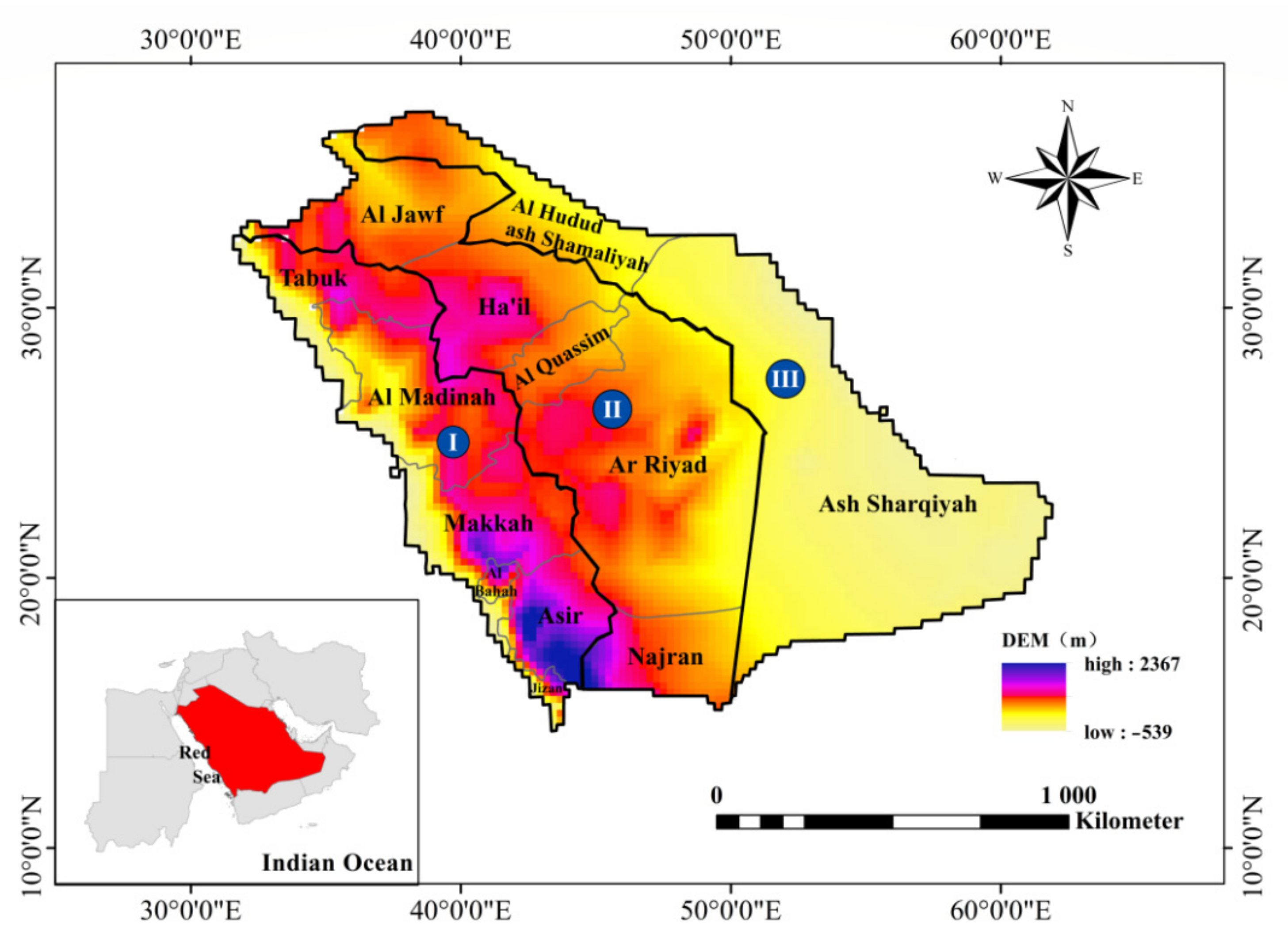
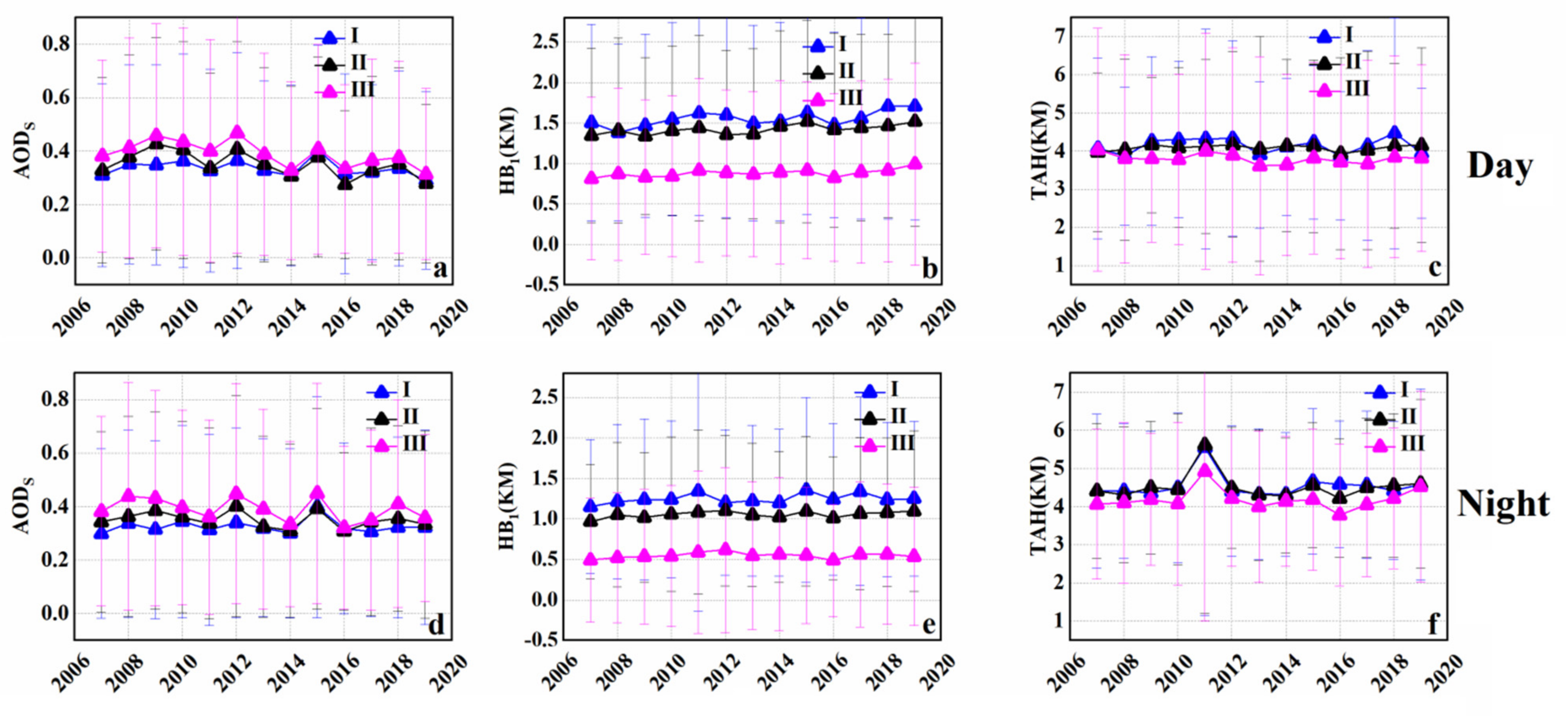
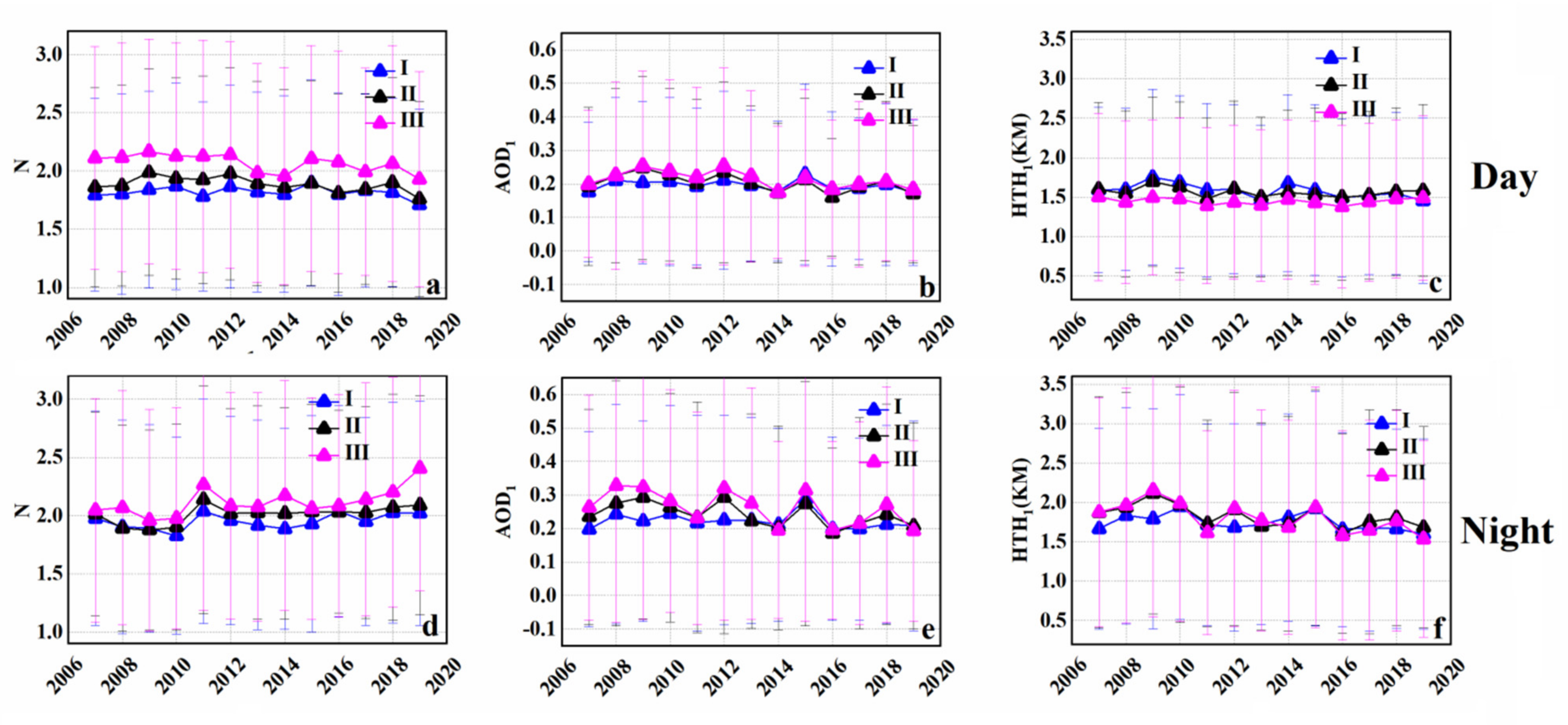
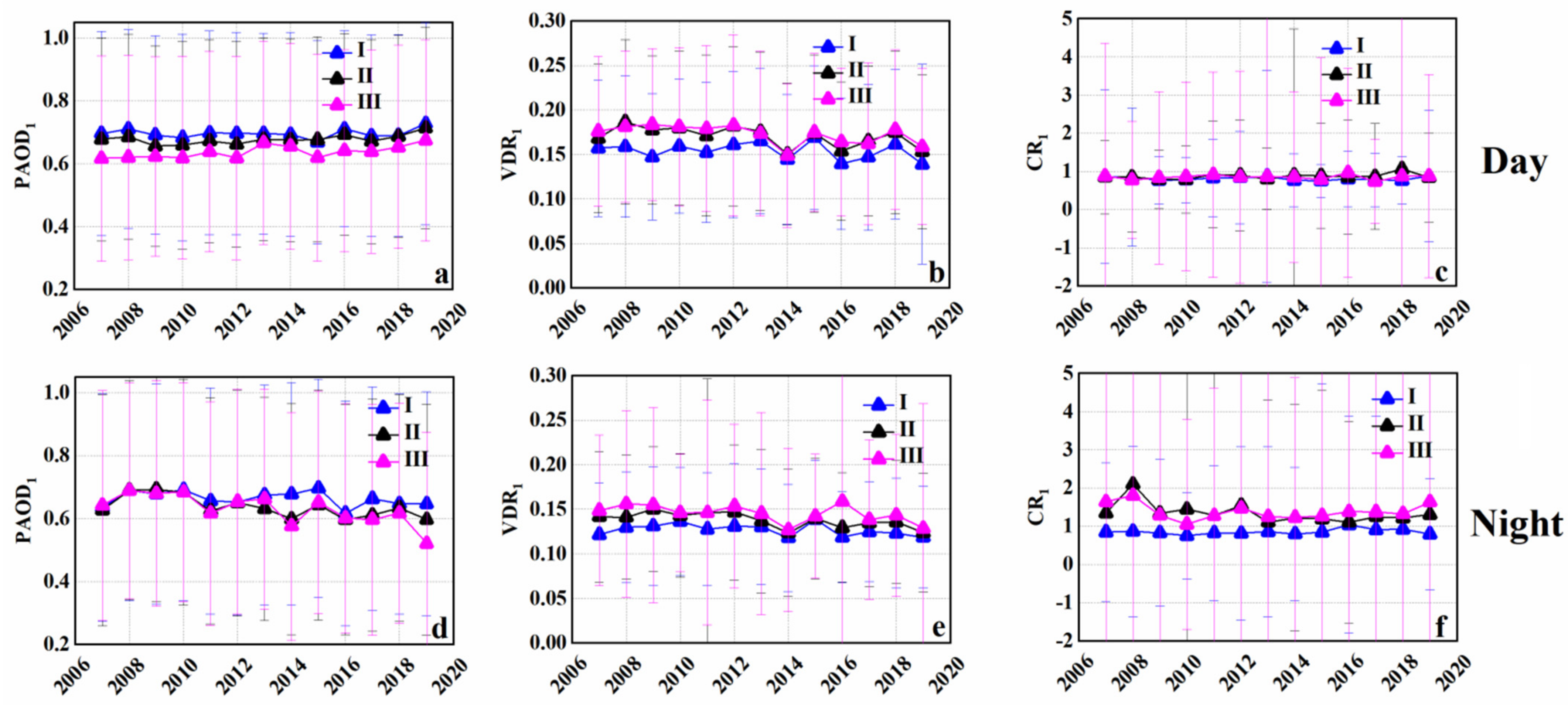
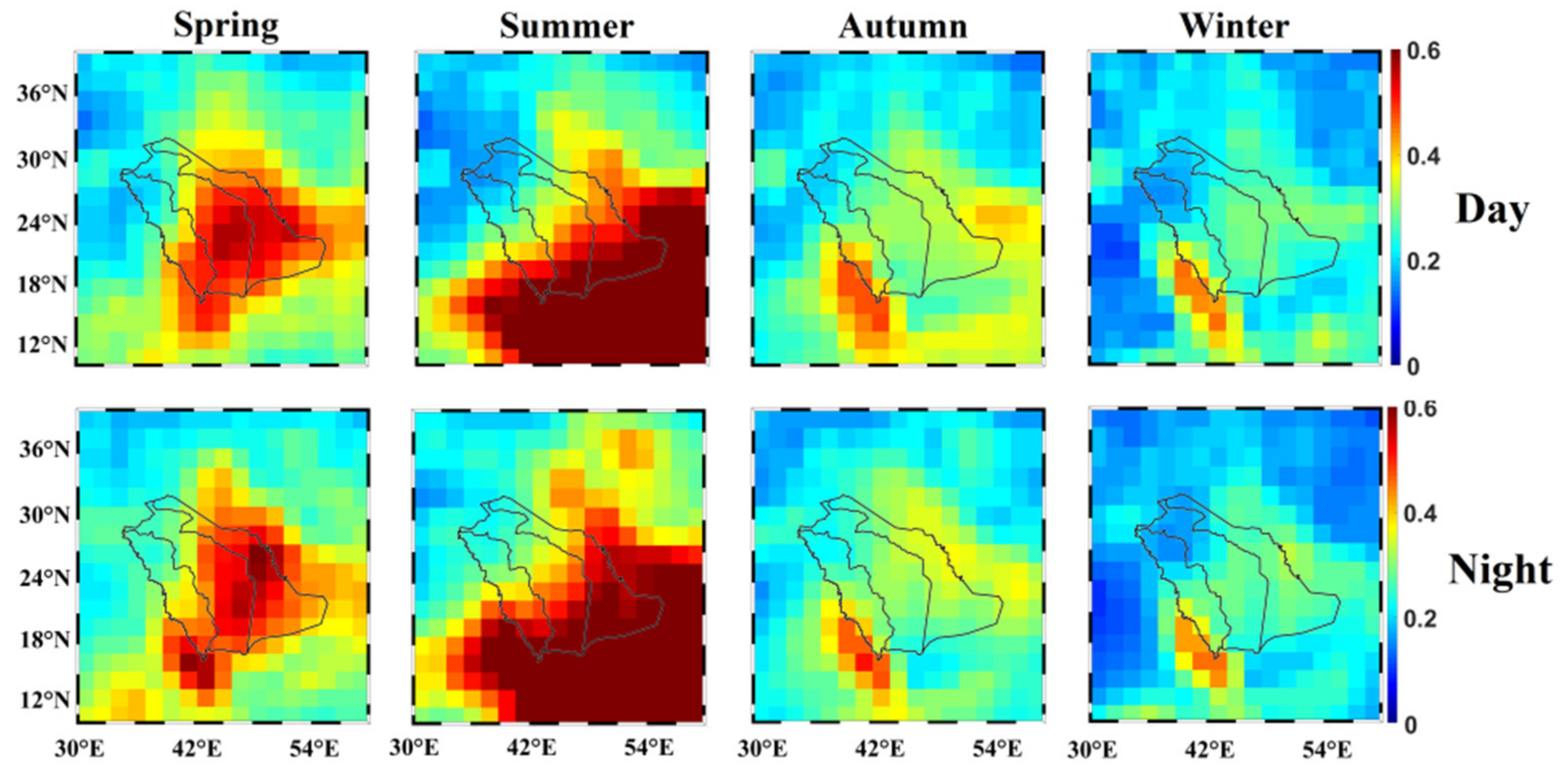

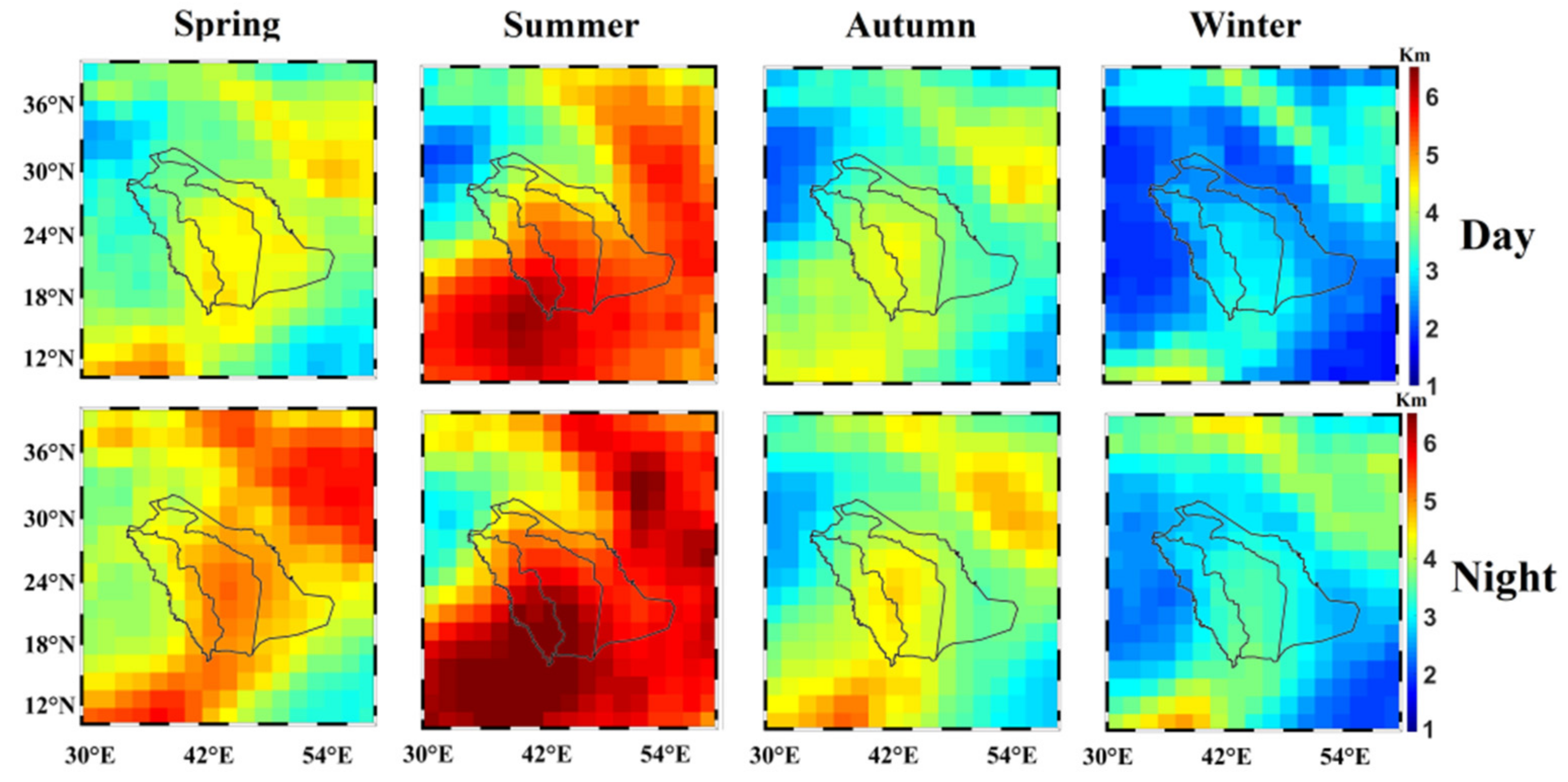
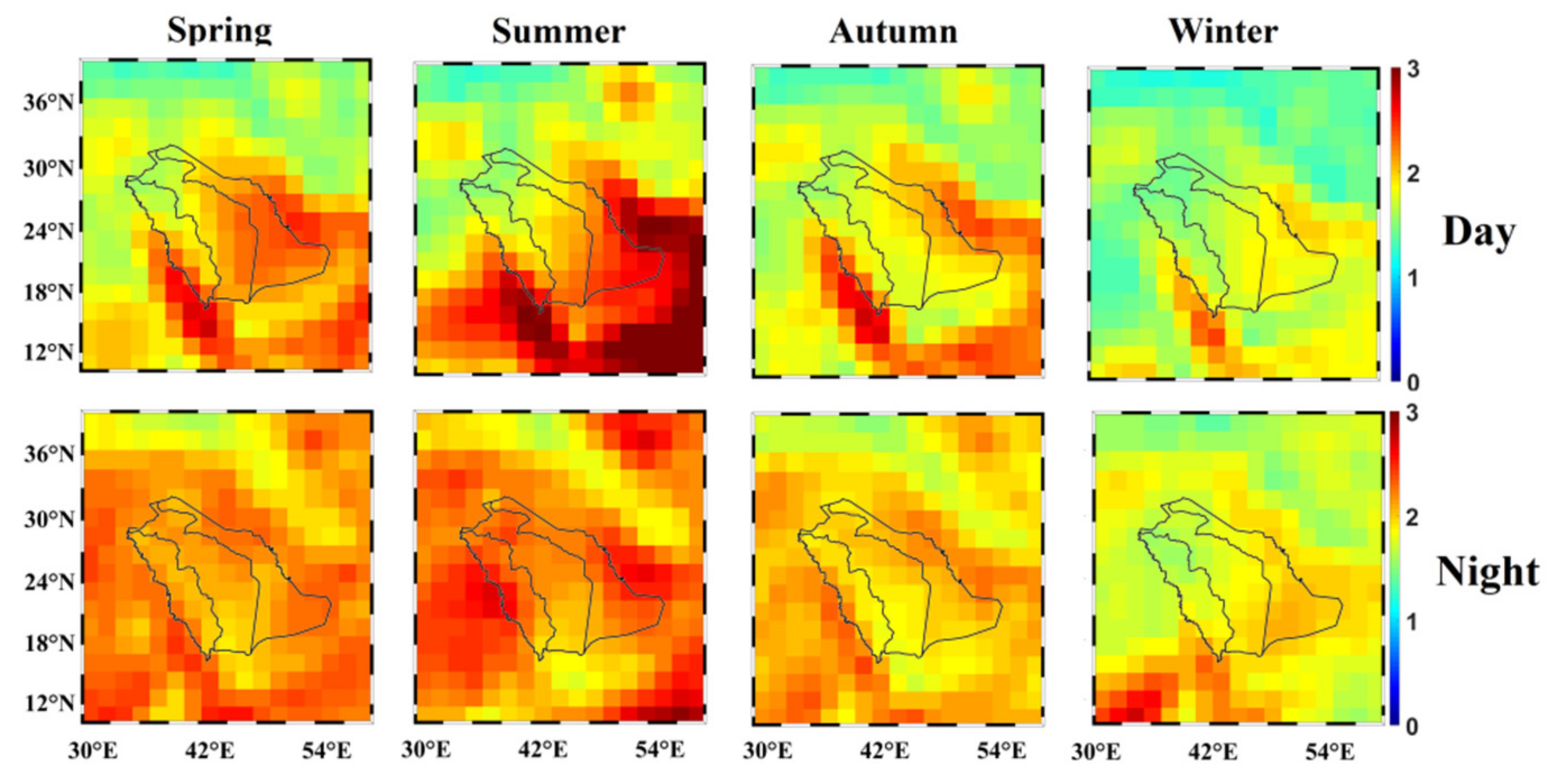

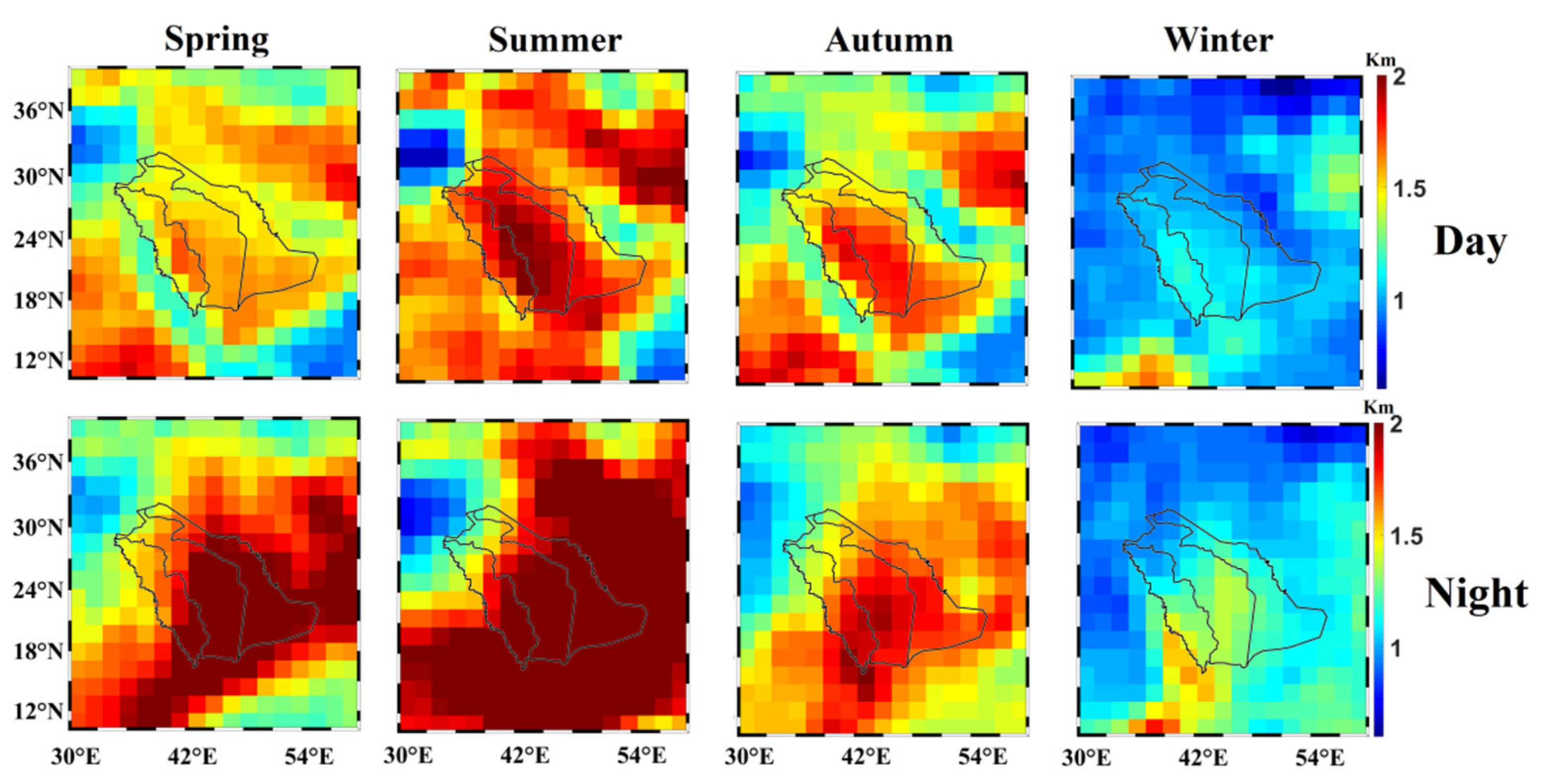
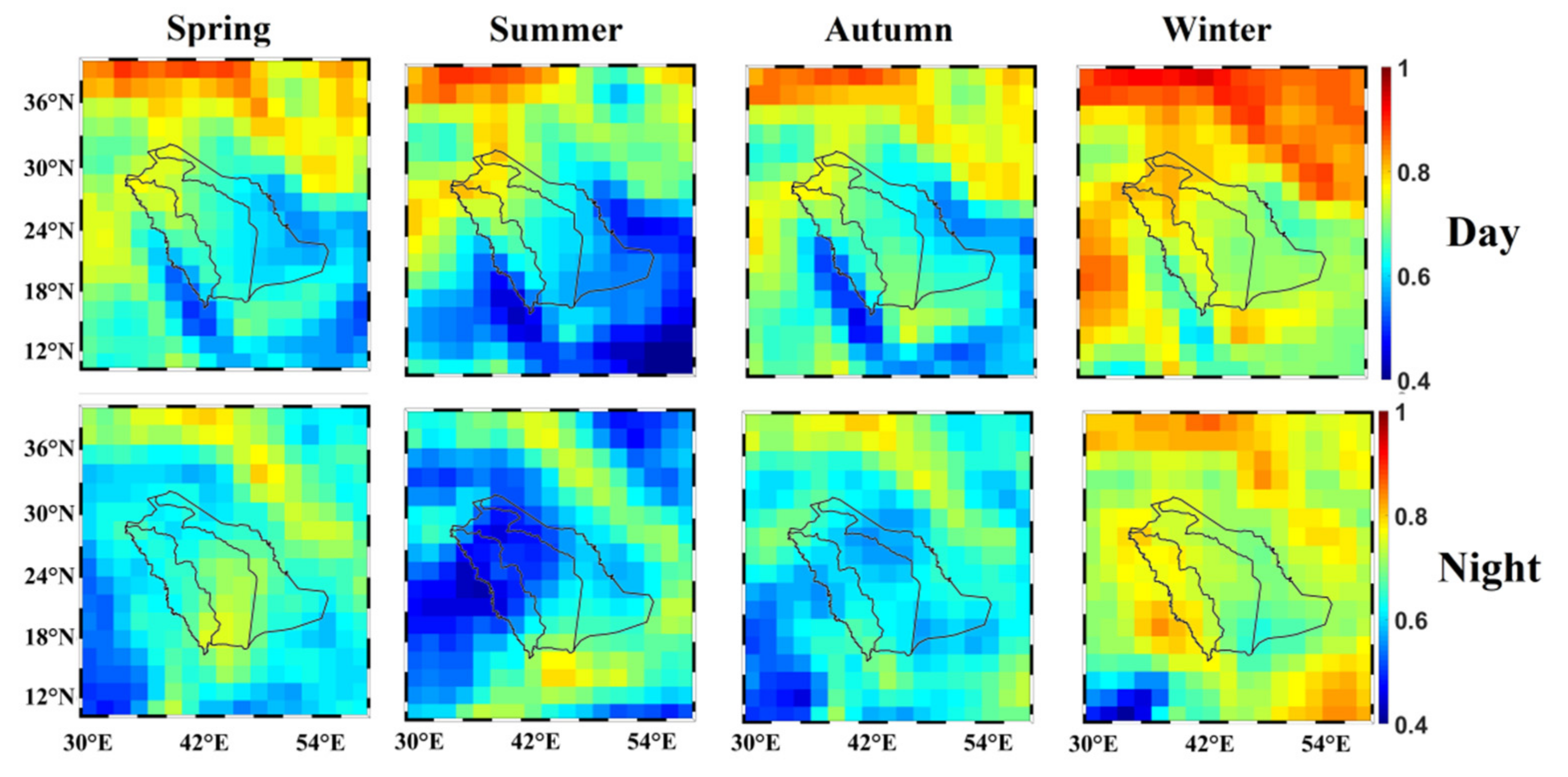
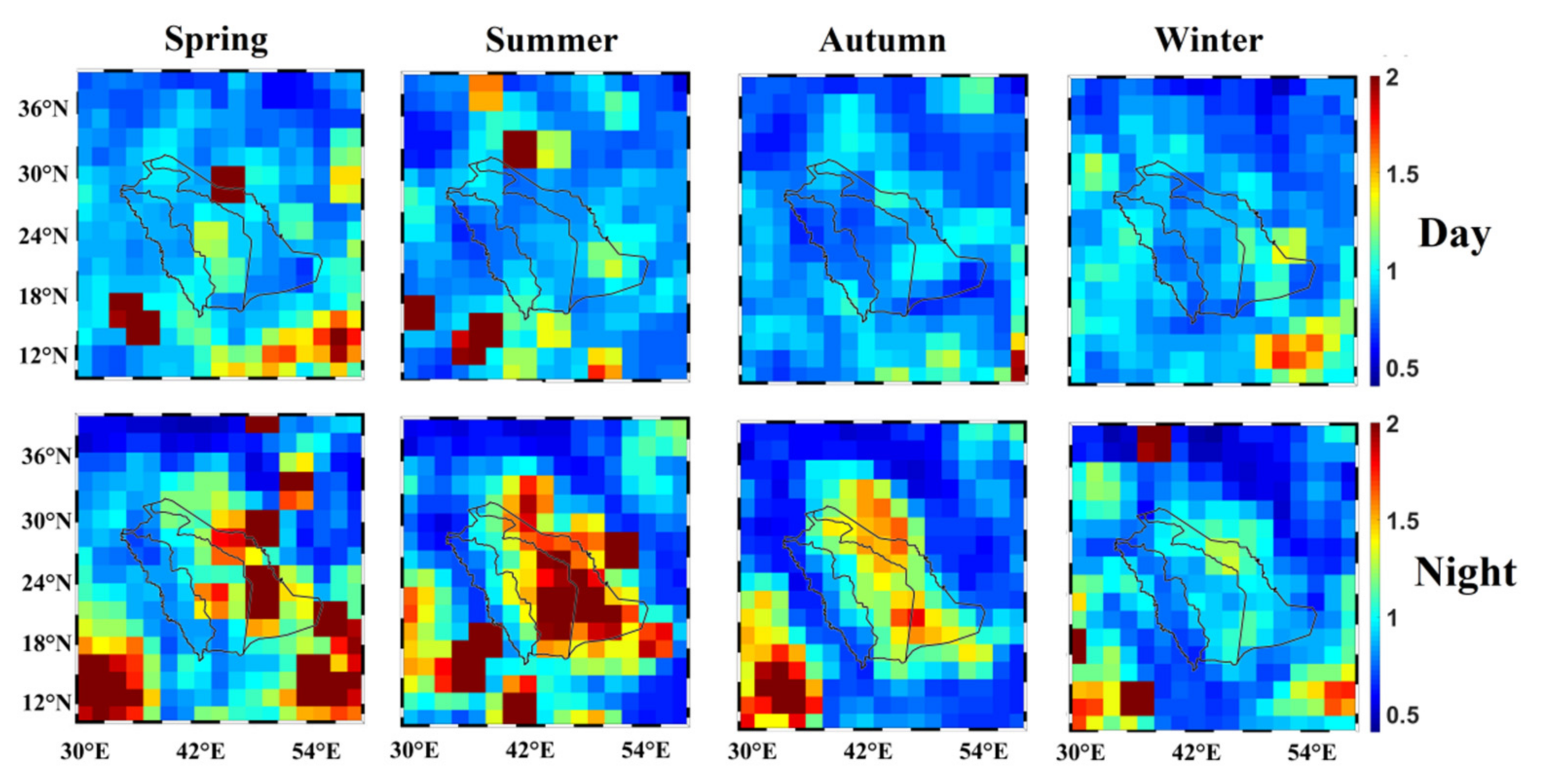
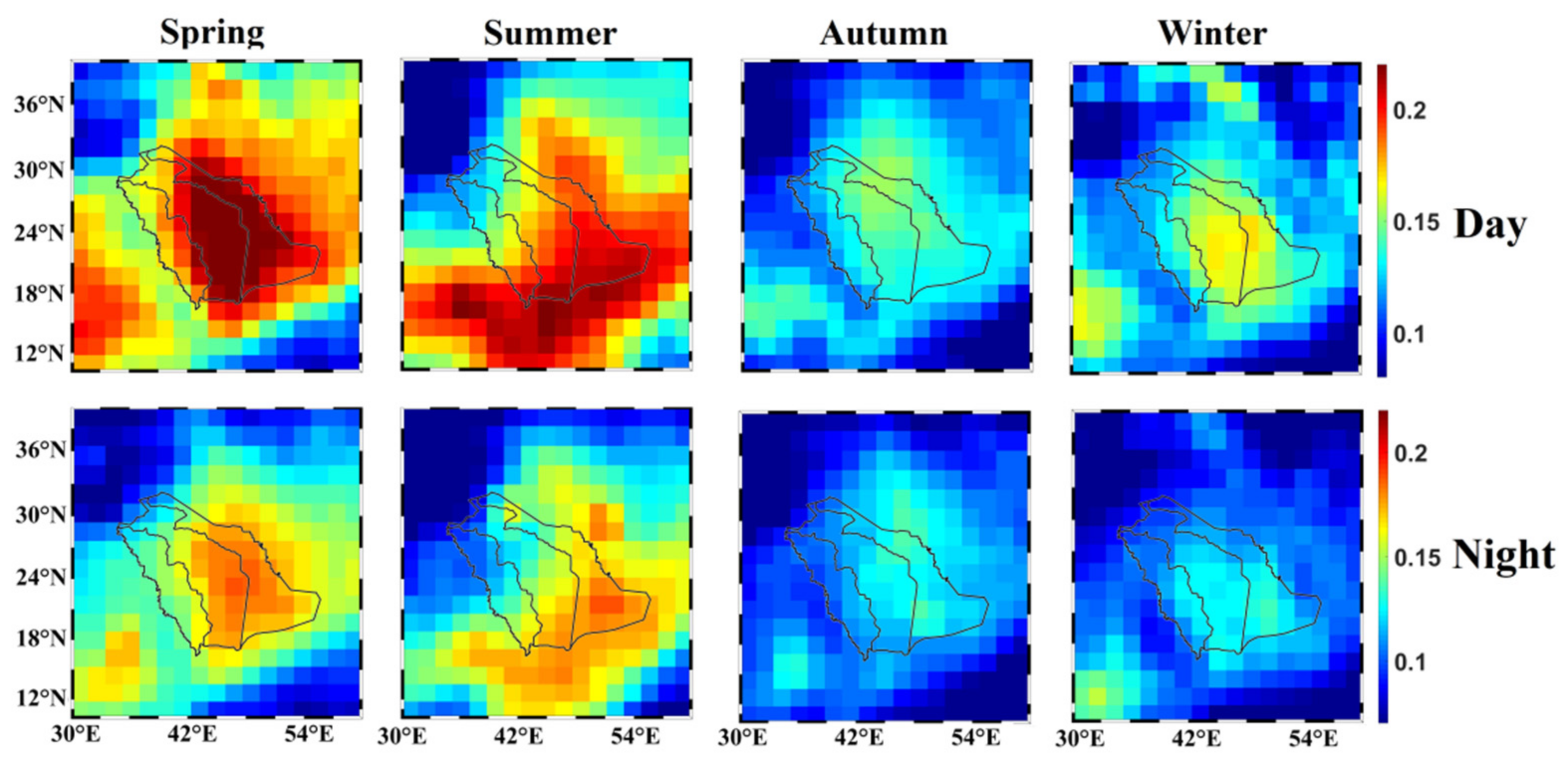
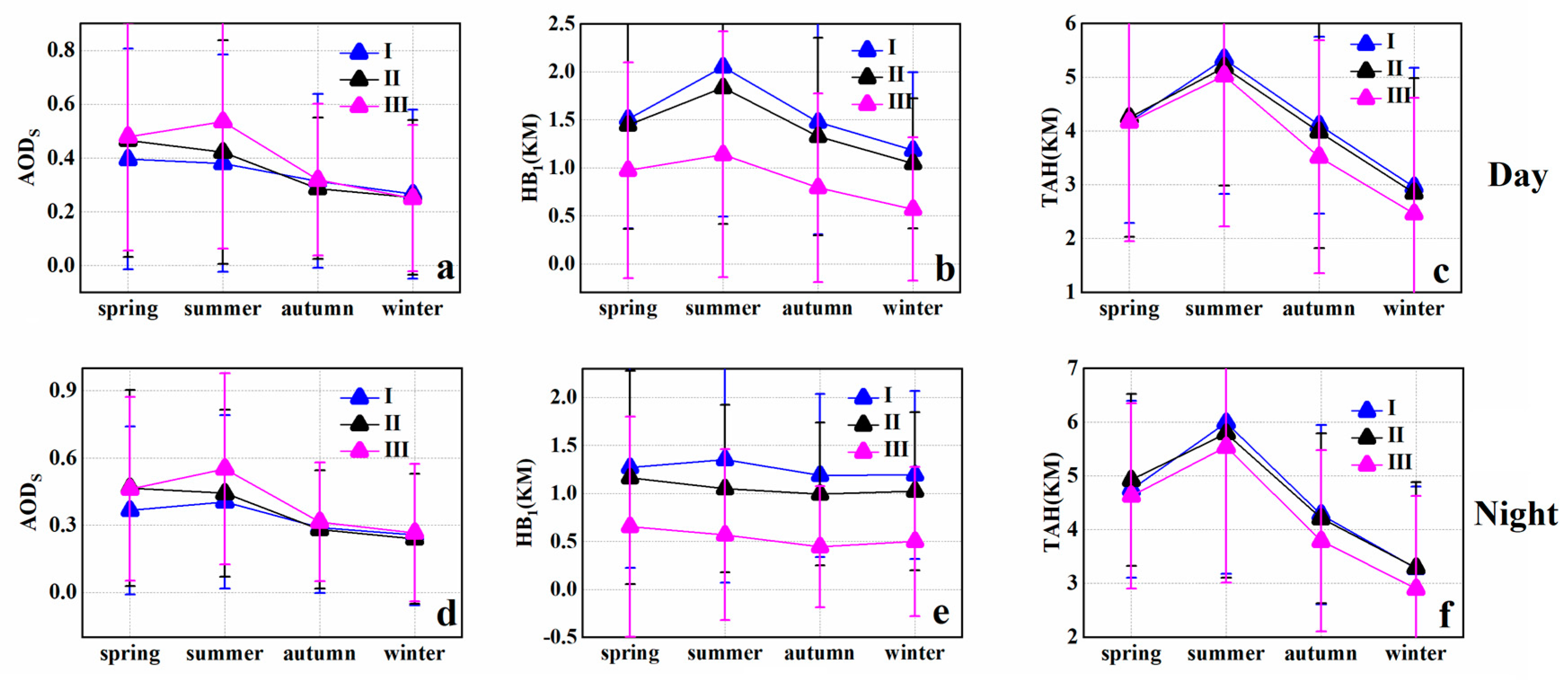

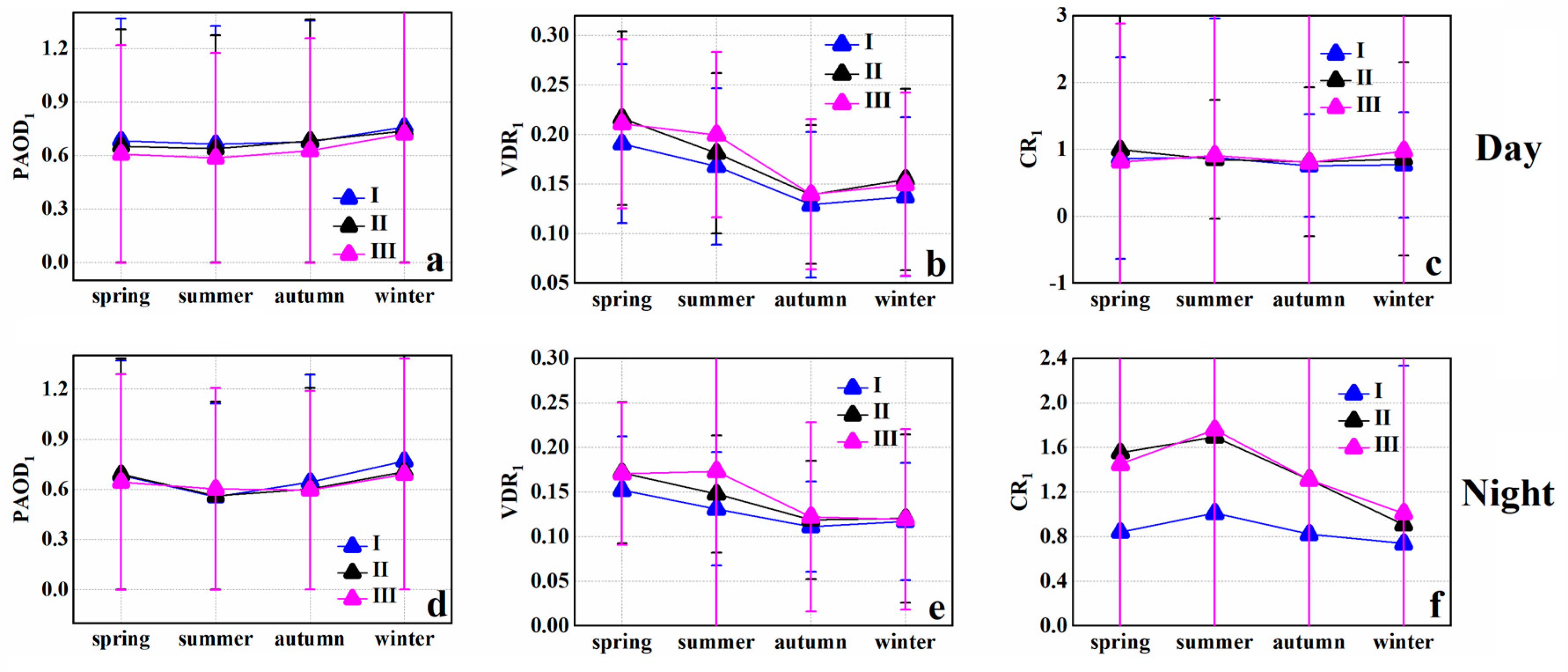

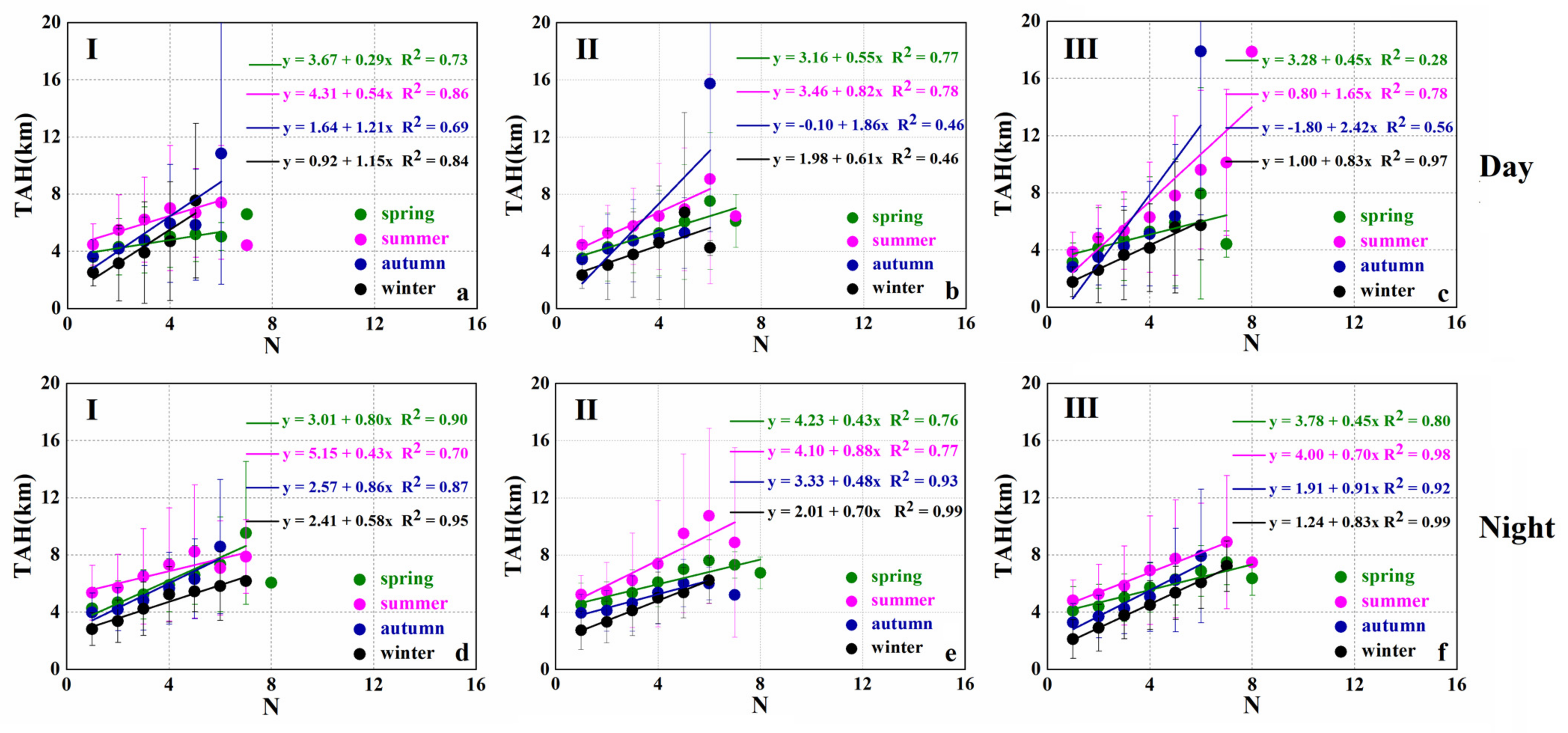
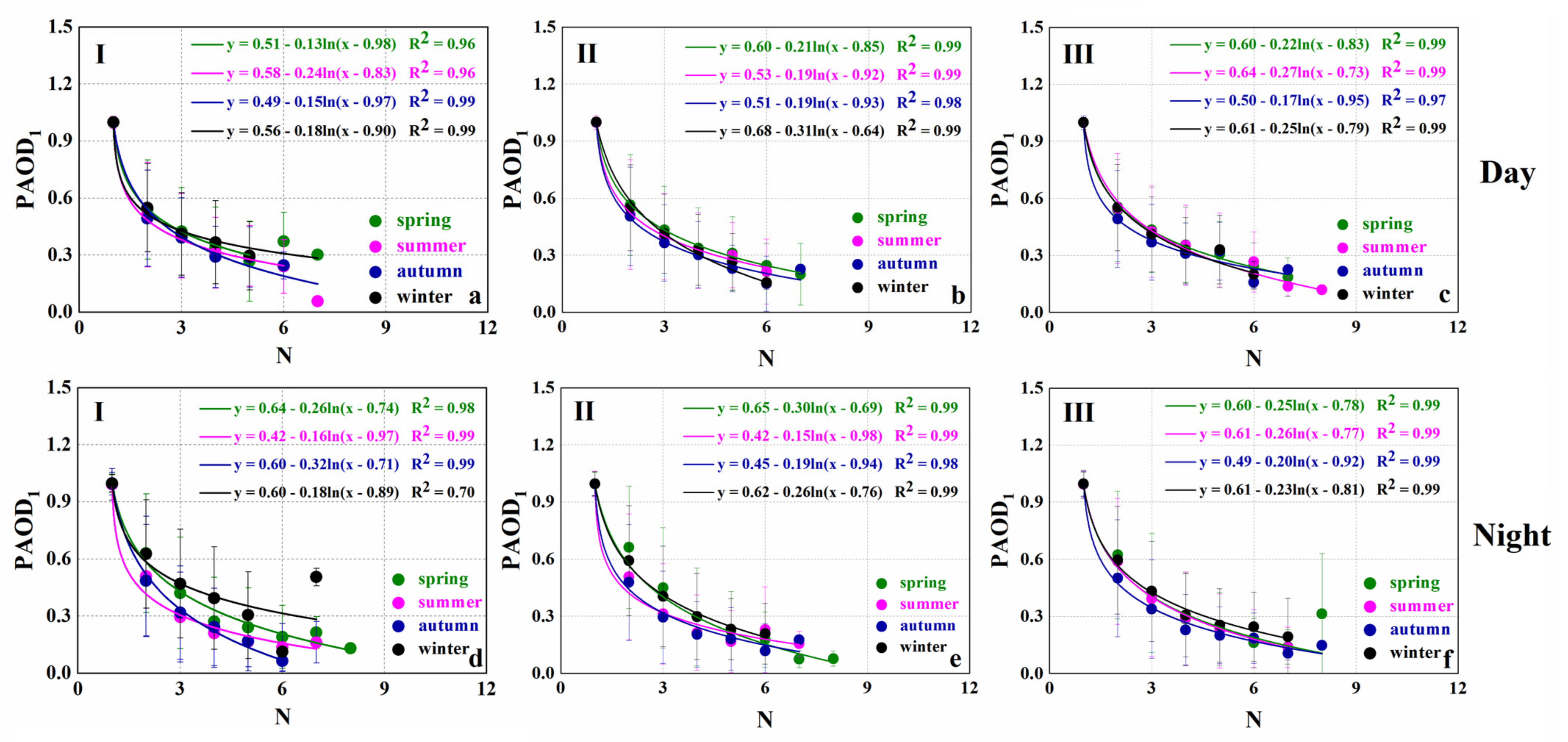
| Parameter | Abbreviation | Parameter | Abbreviation |
|---|---|---|---|
| AOD of the lowest aerosol layer | AOD1 | The base height of the lowest aerosol layer | HB1 |
| The top height of the lowest aerosol layer | HT1 | The color ratio of the lowest aerosol layer | CR1 |
| AOD proportion of the lowest aerosol layer | PAOD1 | Volume depolarization ratio of the lowest aerosol layer | VDR1 |
| Number of aerosol feature layers | N | The top altitude of the highest aerosol layer | TAH |
| The sum of the AOD derived from all aerosol layers | AODS | The thickness of the lowest aerosol layer | HTH1 |
Publisher’s Note: MDPI stays neutral with regard to jurisdictional claims in published maps and institutional affiliations. |
© 2021 by the authors. Licensee MDPI, Basel, Switzerland. This article is an open access article distributed under the terms and conditions of the Creative Commons Attribution (CC BY) license (https://creativecommons.org/licenses/by/4.0/).
Share and Cite
Zhang, Z.; Su, B.; Chen, Y.; Lan, J.; Bilal, M.; Pan, M.; Ilyas, S.; Khedher, K.M. Study on Vertically Distributed Aerosol Optical Characteristics over Saudi Arabia Using CALIPSO Satellite Data. Appl. Sci. 2022, 12, 603. https://doi.org/10.3390/app12020603
Zhang Z, Su B, Chen Y, Lan J, Bilal M, Pan M, Ilyas S, Khedher KM. Study on Vertically Distributed Aerosol Optical Characteristics over Saudi Arabia Using CALIPSO Satellite Data. Applied Sciences. 2022; 12(2):603. https://doi.org/10.3390/app12020603
Chicago/Turabian StyleZhang, Ziyue, Bo Su, Yuanyuan Chen, Jinjing Lan, Muhammad Bilal, Miaomiao Pan, Sana Ilyas, and Khaled Mohamed Khedher. 2022. "Study on Vertically Distributed Aerosol Optical Characteristics over Saudi Arabia Using CALIPSO Satellite Data" Applied Sciences 12, no. 2: 603. https://doi.org/10.3390/app12020603







